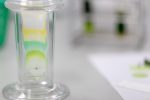The trickle-bed reactor (TBR) is a type of fixed-bed reactor used in various chemical and biochemical processes, particularly in gas-liquid-solid reactions. It is designed to facilitate mass transfer between a gas phase and a liquid phase while passing through a fixed bed of solid catalyst particles. Trickle-bed reactors are commonly employed in processes that involve catalytic reactions, gas absorption, and gas-liquid reactions where the catalyst is immobilized (Satterfield, 1975; Herskowitz & Smith, 1983; Gianetto & Specchia, 1992; Ranade et al., 2011).
Here’s how a trickle-bed reactor typically works:
- Reactor Structure: The reactor consists of a vertical cylindrical vessel filled with a bed of solid catalyst particles. The catalyst bed is often supported by a distributor plate at the bottom of the reactor, which ensures uniform gas and liquid distribution.
- Gas and Liquid Flow: The gas phase containing the reactant or the gas to be absorbed is introduced into the reactor from the bottom. Simultaneously, the liquid phase (often a liquid reactant or a solvent) is trickled down over the catalyst bed from the top. The liquid is typically fed through spray nozzles or other distribution systems to ensure even distribution over the entire cross-section of the catalyst bed.
- Mass Transfer: As the gas and liquid pass through the catalyst bed, mass transfer occurs at the solid-liquid-gas interfaces. The gas-phase reactants diffuse into the liquid phase and come into contact with the catalyst, where the chemical reaction takes place. The reaction products and unreacted components are carried along with the liquid as it continues to trickle down through the bed.
- Liquid-Gas Separation: At the bottom of the reactor, the liquid-gas mixture exits the catalyst bed and undergoes separation. Often, gas-liquid separators or coalescers are used to remove the gas from the liquid phase, allowing the gas to exit the reactor while the liquid is recycled or sent for further processing.
Advantages of Trickle-Bed Reactors:
- Efficient Mass Transfer: The continuous flow of liquid through the catalyst bed enhances mass transfer and allows for better contact between the reactants and the catalyst surface, leading to higher reaction rates.
- Good Heat Transfer: The trickling action of the liquid helps dissipate heat generated during exothermic reactions, which can be advantageous in maintaining temperature control.
- Low Pressure Drop: Trickle-bed reactors generally have lower pressure drops compared to some other reactor types, which reduces energy consumption.
Applications of Trickle-Bed Reactors:
- Hydrogenation and dehydrogenation reactions
- Fischer-Tropsch synthesis for producing synthetic fuels
- Gas-liquid reactions such as gas absorption and desorption processes
- Catalytic oxidation and reforming processes
Trickle-bed reactors are widely used in the chemical, petrochemical, and refining industries, as well as in environmental applications for air and water treatment. Their efficient mass transfer characteristics make them valuable for various gas-liquid-solid reactions that involve catalysis.
References
Gianetto, A., & Specchia, V. (1992). Trickle-bed reactors: state of art and perspectives. Chemical Engineering Science, 47(13-14), pp. 3197-3213.
Herskowitz, M., & Smith, J. M. (1983). Trickle‐bed reactors: A review. AIChE Journal, 29(1), pp. 1-18.
Ranade, V. V., Chaudhari, R., & Gunjal, P. R. (2011). Trickle bed reactors: Reactor engineering and applications. Elsevier.
Satterfield, C. N. (1975). Trickle‐bed reactors. AIChE Journal, 21(2), pp. 209-228.

Leave a Reply